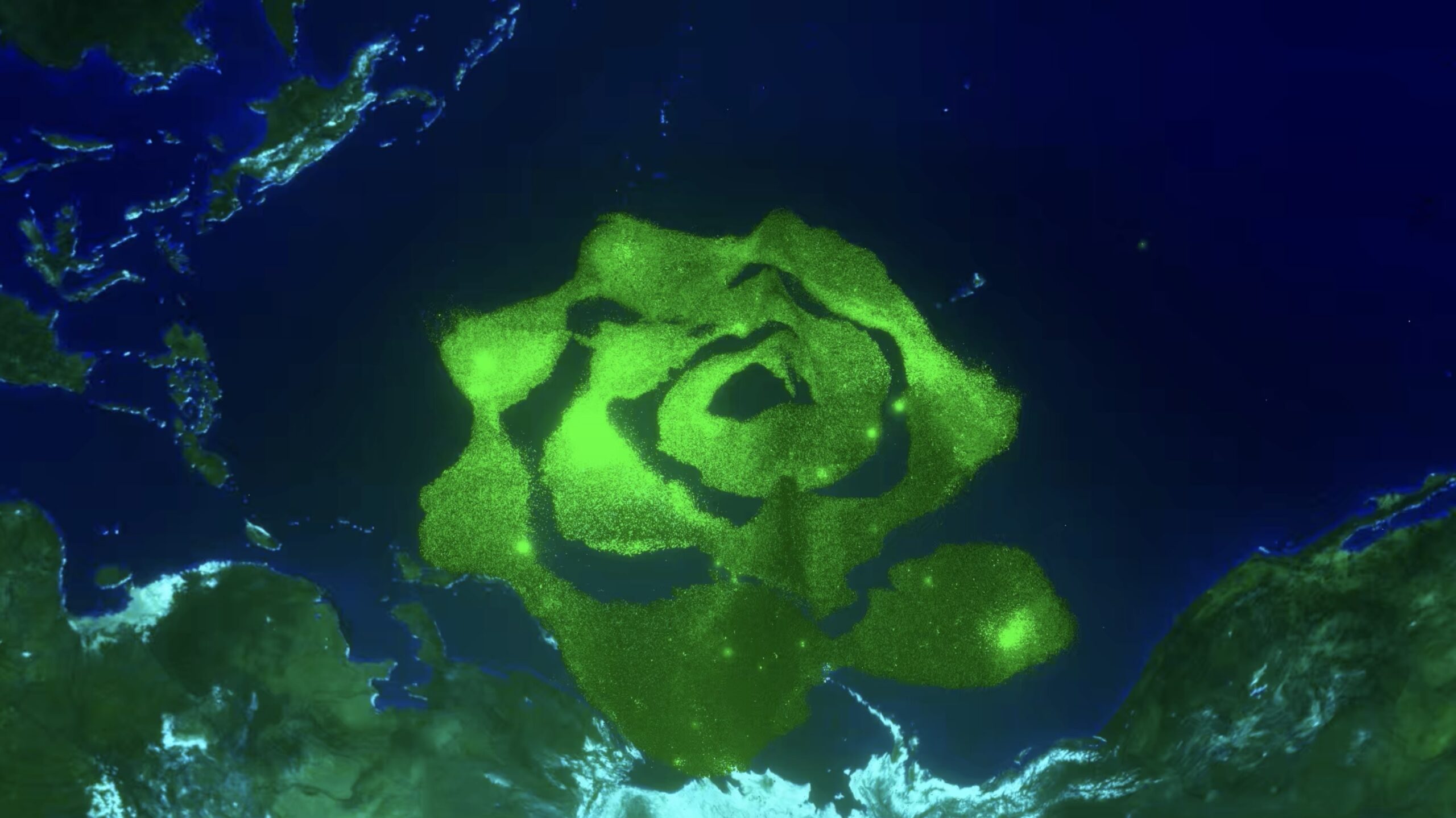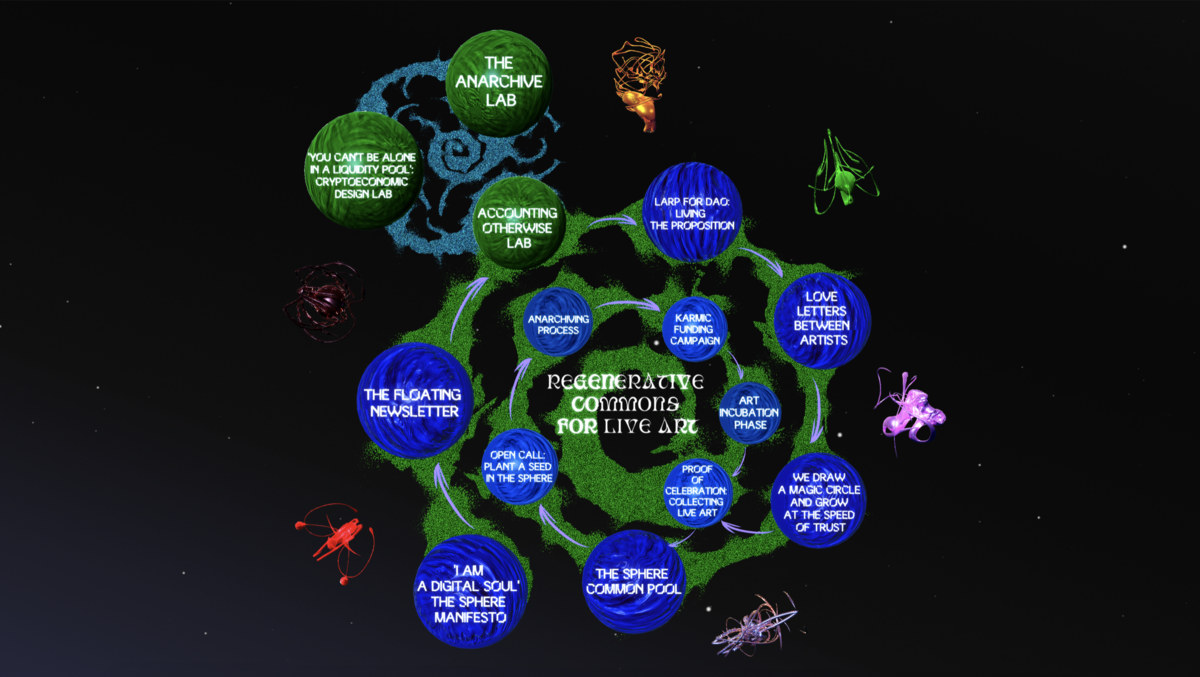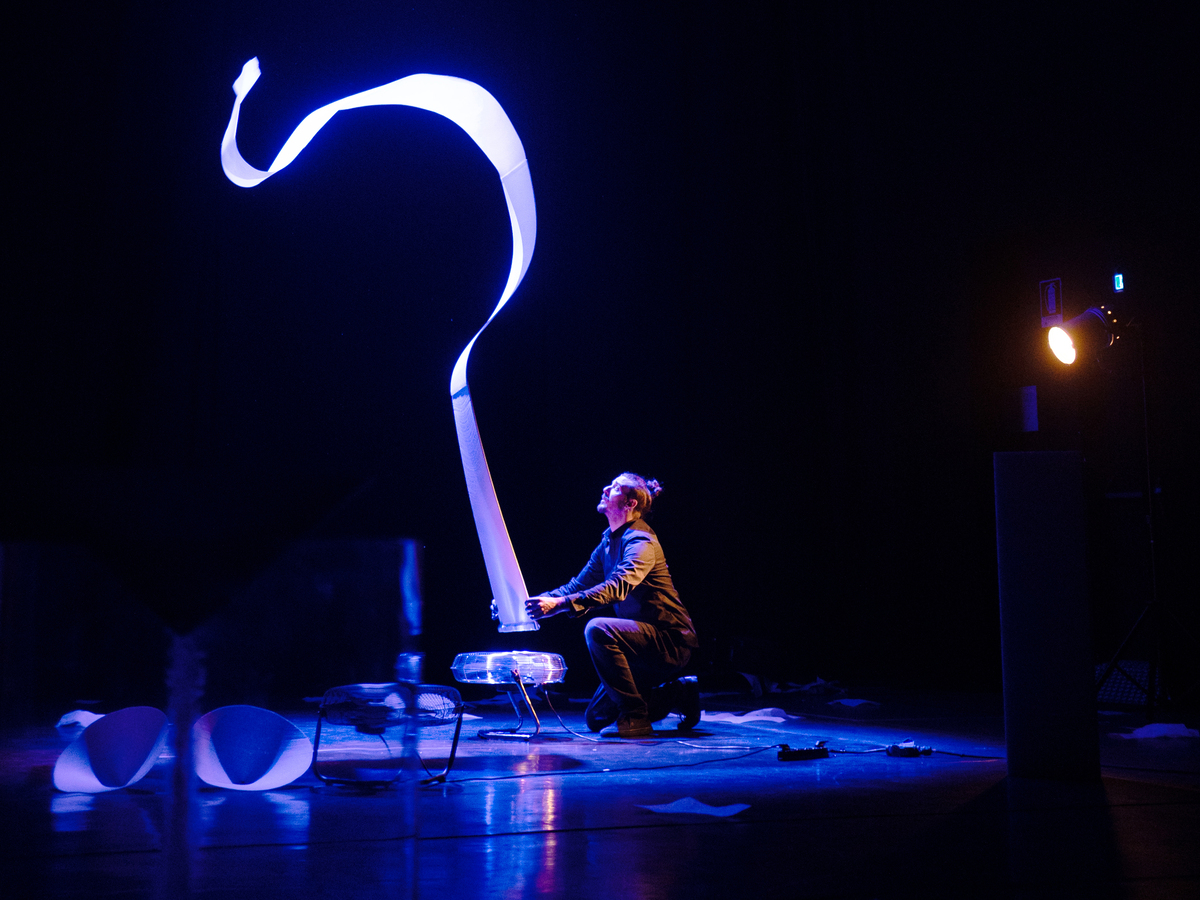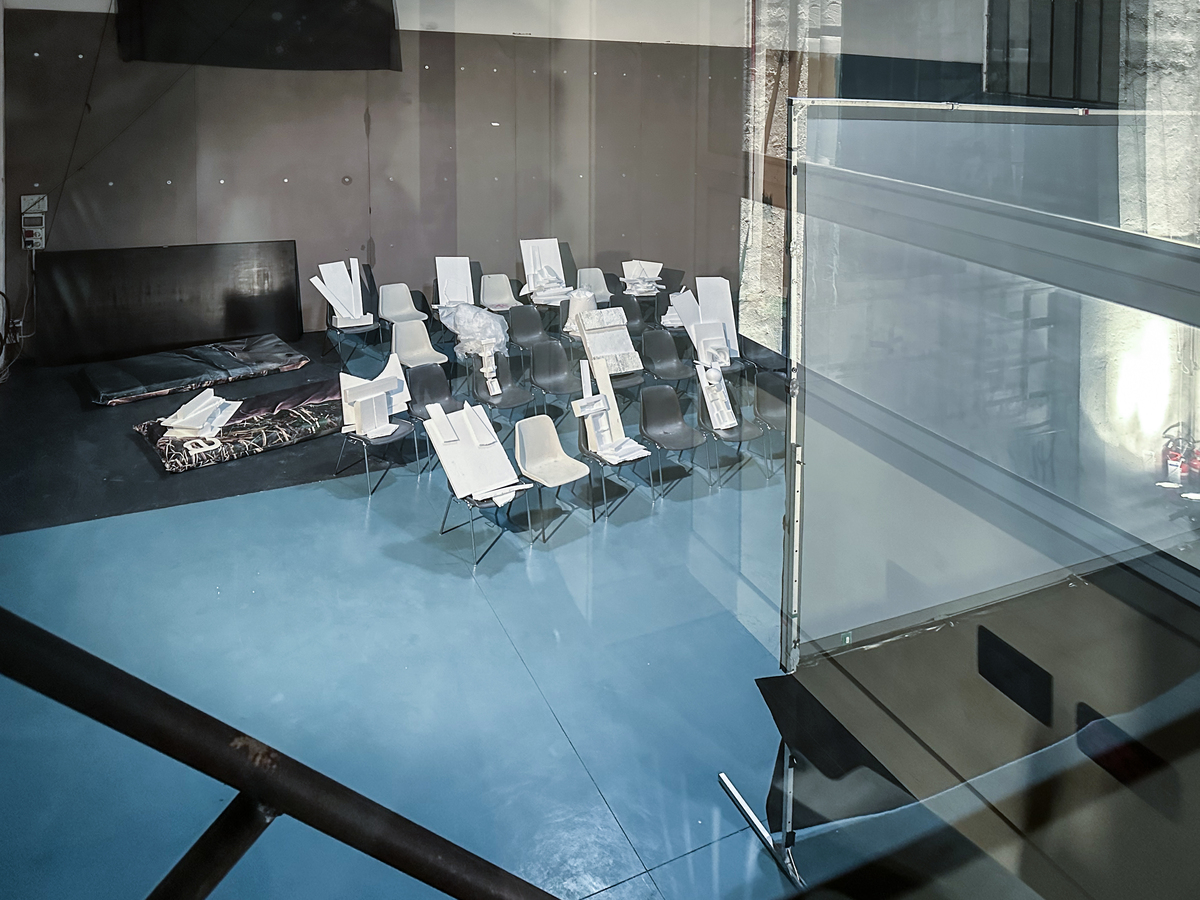Unsellable
The "garbage collectors of the NFT world" buy unwanted tokens for a pittance and preserve as relics of a historic bubble.

Certain art forms are harder to collect—and therefore to monetize—than others. When NFTs came along, many artists working with digital media finally saw a solution to the problem of funding and sustaining their practices via the marketplace. Might blockchain technology serve also as a panacea to performance artists? This is the question that drives the Sphere, a self-described “Circus DAO” that since 2020 has explored different possible mechanisms for the collective ownership and creation of live art. Three members of the core team—Erik Bordeleau, Lene Vollhardt, and Pedro Victor Brandão—got on a call with Outland’s deputy editor Gabrielle Schwarz to discuss the evolution of the project.

GABRIELLE SCHWARZ Let’s start at the beginning. How did the Sphere DAO come about?
ERIK BORDELEAU The Sphere started as an encounter between the world of blockchain and the performing arts. The artistic duo Sara de Vylder and Olle Strandberg Colling, who have a background in the circus arts, were looking for different types of formats for circus productions. Lene and I used to be part of a leftist start-up–slash–thinktank called Economic Space Agency, and we met when they came to a talk we gave at the Moderna Museet in Stockholm. We were part of an exhibition called “Manipulating the World” curated by Goldin + Senneby.
Together with Sara and Olle, we started imagining what the Sphere could be. In September 2018, at a residency on the island of Gotland in Sweden, we drafted our first diagram of the Sphere ecosystem. We were already envisaging a sort of co-owning structure in which the audience and the artists could together create a stakeholding protocol—a “digital soul”—around the artworks. In 2020, after one failed attempt, we received a three-year grant from Creative Europe which allowed us to develop the Sphere as we know it today.
SCHWARZ And can you talk me through how this stakeholding protocol works?
LENE VOLLHARDT It’s important to note that the circus arts, and the live arts more broadly, are a pretty marginalized art form, which doesn’t have the same infrastructural support as other kinds of contemporary art. For reference, in the UK and Europe, the live arts funding sector has been cut drastically since 2020, decreasing year by year. In addition, the gallery system does not exist, the system of critics upholding a discourse around the art form doesn’t exist. This has various implications for artists, one of which has to do with the fine line between appropriation and reiteration, which becomes very tense when you’re operating in a capitalist system.
That’s why we decided to look to Primavera De Fillippi’s Plantoid (2015) as an inspiration for a blockchain-based infrastructure which would allow for the reiteration or the remaking of a live artwork, in a way that has financial consequences—for the entire milieu, not just the individual artist. Basically everything we’re developing in the Sphere has to do with playing with protocol expectations and with how people can co-own artworks in a different way to how they’re used to.

BORDELEAU The first year of our grant was for research-creation, and after that we came up with the art mechanism inspired by the Plantoid. Basically, we voted on proposals for what we called “seed performances” and we ran a funding campaign—we called this the Karmic Funding Campaign—to allow for these, plus a number of derivative performances, to be realized. In total, including our grant budget, we raised enough money to finance two seed performances and three derivatives.
The selected seed artists were asked to write “love letters” stating the conditions for how their works should be respected and preserved in future iterations. This can be thought of as securing the source code which future artists can iterate upon. The conditions can be quite minimal. For instance, we’re working with one seed performance by Andrea Salustri, MATERIA (2023), that uses polystyrene as the subject of the work. His conditions are: first, the derivative works must be called MATERIA 2.0, 3.0, etc.; and second, they should always consider polystyrene as a subject, not an object. Later on we held a second open call in which artists were invited to answer to the love letters with propositions—love letters, truly—of their own, and the Sphere community voted again for which of those would be realized.
SCHWARZ Where does the blockchain come in with this funding process?
PEDRO VICTOR BRANDÃO Web3 has provided the building blocks for the Sphere in a number of ways. The processes for the choosing of the seeds and the derivatives used quadratic voting. For the first seed vote we used Cygnet, a quadratic voting tool created by Black Swan DAO. People could use Discord to vote, they didn’t need a wallet. We also used Mirror.xyz as a tool to crowdfund. We then pooled the fund in a multi-signature wallet.
So far there has only been one Karmic Funding Campaign. It’s a much longer, steadier process than what you see in other timelines in the cryptosphere.
BORDELEAU One thing is, it takes time for the artworks to be generated. They are full-scale performances. For Utka Nehuen Gavuzzo and Marija Baranauskaitė, it took almost a year to make the works.
BRANDÃO They have to rehearse, to do the stage design, to align with the musicians, the sound technicians and so on. A few weeks ago in Turin, for the first time, the seed and derivative performances of Andrea Salutri’s MATERIA were presented together in a festival. It was really interesting to see the three iterations, how each one differs from the other while also being bonded in a very special way.


SCHWARZ That must have been really exciting to see. When we were e-mailing, you mentioned that you have some big plans for future projects as well.
VOLLHARDT Yes! We recently won a grant from Serpentine Arts Technologies and RadicalxChange to develop the next iteration of the Sphere, which is called The Anarchiving Game. This will be launched as part of our Proof of Celebration campaign beginning in April to mark the end of our three-year period of EU funding. That’s also when NFTs that we have attached to the five performances—plus a film which I made, entitled Swirls of Fortune (2024)—will go into circulation on our marketplace, which is called Karmetplace.
BORDELEAU Bitcoin has proof of work, Ethereum has proof of stake, and for everything else alive we have: proof of celebration!
We chose to attach 150 NFTs to each of the five performances. We made this decision based on Dunbar’s number, a popular reference in the crypto world, which was proposed by anthropologist Robin Dunbar in the 1990s. It stands for the maximum number of people you can, as a human primate, maintain a significant relationship with at any one time. We wanted to strike a balance between keeping a sense of community around the artwork that wouldn’t be possible with 10,000 NFTs, while also generating some liquidity.
BRANDÃO We definitely want to gather a responsive community. I think one of the many challenges that DAOs face nowadays is a certain apathy, where the members are just there but they don’t execute actions, they don’t vote.
VOLLHARDT With everything we do, we’re trying to use the fact that we’re working with the informality and spontaneity of live art to test the limits of what it means to protocolize social relationships and interactions. We’re using digital technology to protocolize, but we’re also very attuned to anything that will escape the code. This is the big blind spot in most of the DAO space, where you have a fantasy of automation and you’re losing the actual substance of the sociality that’s being captured in the protocols.
BORDELEAU In that context, the Anarchiving Game is going to basically be a way to extend the graph of relationships that constitute the Sphere as a live art constellation. I like to think of it as a sort of collective value discovery process or digital divinatory practice.
VOLLHARDT There is also the shared financial consequence, which Pedro and Vitor Butkus, our developer, have been crafting.
BRANDÃO Initially, the Sphere was a web3 project with government funding. I don’t know if it was the first but it’s unusual. And now we’re looking at other ways to grow the treasury. We are building infrastructure for the Anarchiving Game on the Zora network. It’s a layer 2, so it’s really cheap to interact with, and it has this structure of minting fee redistribution to support creators.

SCHWARZ So how does the game work exactly?
BRANDÃO It’s still in early development mode, but essentially the role of the anarchivist is to create NFTs called “fragments,” which will form a database that can be used for further interpretations through filters and queries on a webapp. Zora’s revenue share model generates small contributions both for the creators of the fragments and for the Sphere’s common pool. Once this hits a certain threshold we can summon up a new governance ritual to spend that money on building something new.
The reason we designed our own marketplace is so that we can enforce automatic royalties and also other distributions from the sales. If a derivative NFT is sold, for instance, a portion goes to the seed artist, a portion goes to the derivative artist, and a portion goes to our common pool. After the killing of royalties because of Blur, we saw the necessity of creating our own infrastructure, to allow for other utilities for NFTs that go beyond buying and selling.
BORDELEAU Smart contracts were made to have a better royalty system for artists, but it becomes really hard to enforce if you don’t build your own marketplace.
BRANDÃO Within the Proof of Celebration program we’re also planning to organize a show, entitled the “Outer Sphere,” with existing cryptomedia pieces that have some relationship to the live arts.
An artist who has their work shown in the virtual gallery, designed by Tym Novy, will receive a participation fee, even though we are not buying anything. Again, this takes us beyond the binary idea that with NFTs all you can do is buy and sell.
BORDELEAU The Anarchiving Game is a way to gather the community, and the “Outer Sphere” show is a way to extend the community of live art. In the end, it’s all about experimenting with what it means to collect live art.
